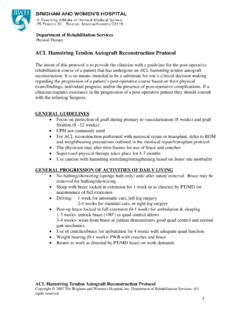Transcription of Developing and Implementing a Career Ladder Program
1 JULY/AUGUST 2007 RADIOLOGY MANAGEMENT42 Developing andImplementing a CareerLadder Programcareer Ladder is a system of employee salary progres-sion that provides for advancement through a set ofgraded steps or on the Ladder occurs inrelation to achievement. According to Peterson,2the firstmodel for clinical advancement was proposed in 1972 goal of this first Career Ladder was toincrease retention and bring higher levels of recognized and rewarded excellence and they pro-vided room for Career growth, learning, and et al5define clinical ladders as a voluntary promo-tion, designed to recognize the increasing skills andresponsibilities of personnel without requiring theemployee to seek promotion to the supervisory level or toleave direct clinical practice.
2 Finally, Ripka and Fouser6state that a clinical Ladder Program offers the opportunityto reward extra employee effort and performance whileimproving individual job satisfaction, personal recogni-tion, and patient care. While the preceding definitions aresomewhat different, the overlying theme of all is employeegrowth, recognition, and retention. There are several Program names currently used withthis type of Program clinical ladders and Career ladders arethe most prevalent. Other naming conventions include Pro-fessional Technologist Advancement Program (PTAP),7 Career Advancement Program (CAP),4 MultimodalityCareer Path,2and clinical Practice Recognition there is no precise rationale for determining a namingconvention, Ron Barak, RT(R), CRA, Regional ManagerRadiology, Broward General Medical Center and PaulDubiel, Director of Imaging, Seton Healthcare Networkhave indicated their naming decisions came as a result ofBy Michelle Wall, MS, CRA, RT(R)
3 A Career Ladder Program is a formal management tool used not only bymanagers looking to recognize and retain employees, but also by employeesseeking growth opportunities. A Career Ladder Program involves careful development, frequent and effec-tive communication during implementation, and activities focused onmeasuring Program effectiveness. Career ladders are a way to increase productivity and staff versatility;improve morale, clinical quality, and staff satisfaction; reduce turnover;promote professional growth and job enrichment; and improve credit earned from the QuickCreditTMtest accompanying this articlemay be applied to the AHRA certifiedradiology administrator (CRA) human resource management 6/21/07 9:48 AM Page 42 RADIOLOGY MANAGEMENTJULY/AUGUST 2007existing nursing Career Ladder programs at their respectivefacilities (personal communication, October 2006).
4 In this case study, 4 administrators were surveyed and anadditional 5 Career Ladder programs were analyzed fromavailable literature. Of the feedback received and researchconducted, 9 implemented Career ladders for diagnostic tech-nologists, 6 for CT and special procedures, 5 for MRI andnuclear medicine, 4 for ultrasound, 3 for mammography,and 1 for PACS (see Figure 1). Additionally, 1 person statedfuture plans to implement a Program for CT, MRI, andultrasound and another stated plans to implement a programfor nuclear medicine and Develop clinical Ladders? There are many reasons to implement Career ladders; how-ever, this research indicated reducing turnover/retentionas the reason most cited (see Figure 2).
5 Other reasons to43 Figure Frequency; n = ClericalPACSP lannedCurrentFigure to Implement; n = Turnover/ RetentionStaff SatisfactionGrowth/Job EnrichmentMoraleSalaries Patient Care/ ImproveWait TimeVersatility/ ProductivitySupv OJTI mproved 6/21/07 9:48 AM Page 43 JULY/AUGUST 2007 RADIOLOGY MANAGEMENT implement a Program include staff satisfaction, growth/jobenrichment, morale, salaries, patient care/improve wait time,versatility/productivity, and supervisor training. More inter-esting data was obtained when sources were questionedabout the unexpected benefits of Career Ladder implementation(see Figure 3). Five sources indicated versatility/productivityand 4 sources indicated morale as unexpected benefits.
6 When asked about their reasons for implementation and ifeffectiveness was measured and if acceptable results wereachieved, 2 of the 4 radiology administrators responded yes to both questions and 1 had a mixed response. RichardRagovin, RT (R), Director Radiology, Robert Wood JohnsonUniversity Hospital indicated that he measured the effective-ness of his Program relative to retention and morale andachieved acceptable results. While he did not specifically meas-ure, he feels he has achieved increased versatility. Dubiel meas-ured and achieved acceptable results in many areas after theimplementation of clinical ladders in his department, includ-ing increased technologist satisfaction, reduced turnover,increased patient throughput, and reduced patient wait Olivi, MBA, RT(R), FAHRA, CRA, Senior Administra-tor, Department of Radiology, University of Maryland MedicalCenter indicated that while she did not formally measure jobenrichment, the staff has expressed satisfaction with the level ofparticipation, responsibility, and authority afforded by the lad-der Program .
7 Further, Olivi has measured retention and hasseen very little turnover over the last 4 years (personal commu-nication, October/November 2006). Program DevelopmentMuch of the information gathered relating to Career ladderdevelopment is quite varied; however, one common trait isthe formation of a team for Program development. Researchoverwhelming revealed the use of a multi-disciplinary teamapproach to include many levels of radiology leadership:human resources/compensation, radiology educators,senior administrators, radiologists, and staff technologists44 Developing and Implementing a Career Ladder ProgramMuch of the information gathered relating to Career Ladder develop-ment is quite varied; however, one common trait is the formation of ateam for Program Benefits.
8 N = ProductivityMoraleImproved QualityStaff SatisfactionReduce Turnover/RetentionGrowth/Job EnrichmentPatient Care/ Improve Wait 6/21/07 9:48 AM Page 44 RADIOLOGY MANAGEMENTJULY/AUGUST 2007(see Figure 4). Including staff technologists on the develop-ment team would not only help promote buy-in among peers,but would foster staff involvement and ownership. Educatorscan serve to implement and conduct staff education, as wellas bridge communication and serve as a conduit for questionsand concerns. One administrator interviewed suggested thatregular staff meetings included progress reports, allowed forquestions, and sought new ideas.
9 Of the 5 sources listing senioradministrators as team members, 2 clarified their roles as advi-sory and providing approval as is important to emphasize regular working team meet-ings and the realization that the Program will not be built in aday. Pinette states the process was very time consuming andrequired intense discussion and said the great-est challenge in devising a clinical Ladder Program acrossmultidisciplinary lines was to set criteria which would meetthe needs of the diverse the early stages ofprogram development, the team must identify reasons to45In the early stages of Program development, the team must identifyreasons to implement Career ladders, formulate a purpose, and outlinemeasurable goals.
10 Implement Career ladders, formulate a purpose, and outlinemeasurable goals. During the development process, it is important to deter-mine the minimum number of levels required to accomplishestablished goals. Findings among those interviewed for thisstudy indicated 3 levels as most common, but others rangefrom 2 to 7 (see Table 1). All but 2 people stated their firstlevel as entry or new hire. In conjunction with the discussions surrounding the num-ber of levels, the team must decide on the education, experi-ence, behavior objectives, and performance criteria for example, these requirements may include patientsatisfaction indicators, performance evaluation, and qualityassessment that meets or exceeds standards, documentationof expanded productivity, continuing education, directinvolvement in CQI projects, added leadership responsibility,implementation of cost savings initiatives, etc.






